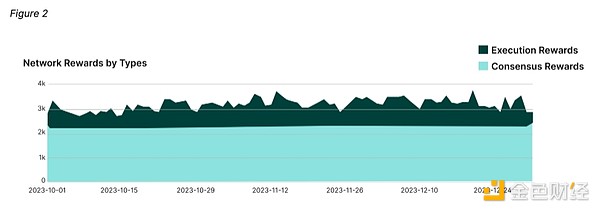Author: Brady, Figment; Compiler: Songxue, Golden Finance
This report covers all Figment Ethereum validators active in October, November and December 2023. We are the largest independent staking provider on Ethereum, with over 5% of ETH staked on the Figment validator. Unless otherwise noted, all data used in this report was provided by the Figment data team.
In order to fully understand the performance of a validator, it is important to consider various factors and evaluate its performance over a longer period of time. Due to selective data, transaction fee volatility, and randomness in validator selection, comparing individual validators over a short period of time does not provide an accurate indicator.
Indicators:
Approximately 23% of the ETH circulating supply is pledged;
Figment’s average SRR rate throughout the fourth quarter was 4.2%;
0 double signature reduction events on Figment validator;
Figment Ethereum validator participation rate in the fourth quarter was 99.9%.
Ethereum’s transition to Proof-of-Stake goes live in September 2022. This network upgrade creates stakes for validators who submit ETH to help secure transactions and mint new Ethereum. Prior to last fall’s merger, more than 10 million ETH was ready to begin staking among 400,000 validators from launch.
In the months since the merger, the number of stakings has steadily increased as more holders staked at least 32 ETH. According to data from BeaconScan, the total value locked in staking has increased from 495,000 validators on January 1, 2023 to over 800,000 validators as of December 2023, equivalent to more than 23% of the total ETH supply.

Rewards
As Ethereum moves from Proof-of-Work to Proof-of-Stake, validators receive both Consensus Layer (CL) and Execution Layer (EL) rewards. CL awards accounted for the majority of Q4 awards at approximately 75%, while EL awards accounted for approximately 25%.
Consensus layer rewards
CL rewards are allocated to validators for attesting, proposing blocks, and participating in the synchronization committee. Attesting blocks is a recurring occurrence and is primarily driven by validator participation rates, which will be discussed later in the report. Figment’s median CL reward performance in Q4 was 0.002282 ETH per validator per day, slightly higher than the network median of 0.002279 ETH per validator per day. Validators also receive EL rewards if they are selected to propose a block.
Execution Layer Rewards
Validators only receive EL rewards when they propose a block, which is a random and rare event (usually happening every 64 days or so). Even if validators are randomly selected to propose blocks, the size of the reward is determined based on the transaction costs on the network. These costs include priority fees and maximum extractable value (MEV) fees for the block. EL fees fluctuate greatly, mainly driven by network traffic during transactions. In Q4, when Figment validators were selected to propose blocks, they received a median of 0.052516 ETH, approximately 3% higher than the network median of 0.05111 ETH. Since EL rewards are randomized, we expect this number to fluctuate from quarter to quarter.
Between these two reward types, CL rewards are much less volatile and less susceptible to "luck factors" than EL rewards - Figure 1 below shows the EL rewards and Variability differences between CL rewards.

Use the median As a metric for reporting Ethereum rewards, it is a more reliable method than using the mean, mainly because of the large variability and outliers in rewards generated by MEV activity. As a measure of central tendency, the median is less sensitive to extreme values and outliers, providing a more representative value for the typical rewards earned by validators.
Participation rate
Every 6-7 minutes, validators on Ethereum are randomly selected to propose and validate new blocks and check their correctness. Afterwards, the committee of proof validators votes on whether to approve the proposed block, and if consensus is reached, the block is added.
Participation rate is a measure of how often a validator successfully attests when selected by the protocol to participate in the committee. A validator may be unable to attest for a number of reasons, including outage or misconfiguration. Therefore, participation rate is a reliable indicator of network uptime and validator stability.
In Q4, Figment performed above the network average, with an average participation rate of 99.9%, 0.3% higher than the average validator.

Cutting eventCutting event

Figment's performance remained strong throughout Q4, with no proposals missed and no cuts due to any penalties. As the chart shows, there were 127 slashing events on Ethereum across other validators throughout Q4, all related to attestation breaches.
Figment pioneered the "safety over liveness" concept on our validator infrastructure, minimizing the possibility of being slashed. We also offer insurance to mitigate losses in the event of a curtailment event.

 Wilfred
Wilfred










